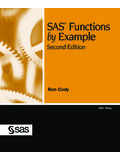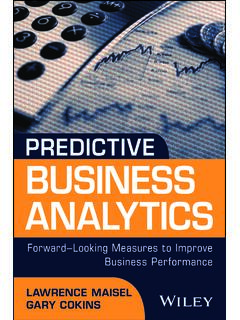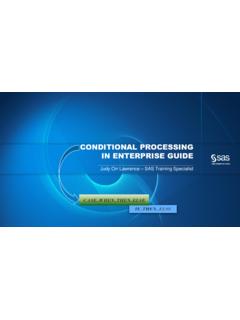Transcription of SAS Functions by Example
1 Examples fromExamples fromSAS Functions by SAS Functions by ExampleExampleRon CodyRon CodyHerman Lo Herman Lo Technical Analyst, RBC Capital MarketsTechnical Analyst, RBC Capital MarketsAgendaAgenda Book StructureBook Structure Examples from the BookExamples from the Book Character Functions (CATS, CATX)Character Functions (CATS, CATX) Date and Time Functions (INTCK, INTNX)Date and Time Functions (INTCK, INTNX) Descriptive Stats (IQR, SMALLEST/LARGEST)Descriptive Stats (IQR, SMALLEST/LARGEST) Special Functions (INPUT, PUT)Special Functions (INPUT, PUT) Macro Functions (CALL SYMPUT, CALL SYMPUTX)Macro Functions (CALL SYMPUT, CALL SYMPUTX) The VerdictThe VerdictBook StructureBook Structure TOC TOC List of ChaptersList of Chapters List of ProgramsList of Programs At the beginning of each chapterAt the beginning of each chapter List of FunctionsList of Functions Inside each chapterInside each chapter For each functionFor each function PurposePurpose SyntaxSyntax Examples/Anticipated OutputsExamples/Anticipated Outputs A Sample ProgramA Sample Program At the backAt the back List of FunctionsList of Functions Index (Alphabetical)Index (Alphabetical)Character FunctionsCharacter Functions CATS(stringCATS(string--1, string1, string--2 2.))
2 Joins strings, stripping both leading and trailing blanksJoins strings, stripping both leading and trailing blanks CATX(stringCATX(string--1, string1, string--2 2 ..)) Joins strings, stripping both leading and trailing blanks, and Joins strings, stripping both leading and trailing blanks, and add a space in between themadd a space in between them ExampleExampleA = A = StarStar B = B = WarsWars CATS(A, B) = CATS(A, B) = StarWarsStarWars CATX(A, B) = CATX(A, B) = Star WarsStar Wars (See Pg. 57(See Pg. 57--58)58)Date and Time FunctionsDate and Time Functions INTCK(INTCK( intervalinterval<Multiple> <.shift> <Multiple> <.shift> ,,date1,date2)date1,date2) Returns Returns numbernumberof of Intervals Intervals between between date1date1and and date2date2 Date1 and Date2 Date1 and Date2 can be can be date, time, date, time, datetimedatetimevaluesvalues datedate: : 01 JUN200001 JUN2000 dd time: time: 9:15:099:15:09 TT datetimedatetime:: 01 JUN2000:9:15:0901 JUN2000:9:15:09 DTDT Interval = The unit of the intervalInterval = The unit of the interval Interval(Interval(datedate) = DAY, WEEK, WEEKDAY, ) = DAY, WEEK, WEEKDAY.
3 Interval(Interval(timetime) = SECOND, MINUTE, HOUR) = SECOND, MINUTE, HOUR Interval(Interval(datetimedatetime) = DTDAY, DTWEEK, DTWEEKDAY, ) = DTDAY, DTWEEK, DTWEEKDAY, ..Date and Time FunctionsDate and Time Functions INTCK(INTCK( intervalinterval<Multiple> <.shift> <Multiple> <.shift> ,,date1,date2)date1,date2) MultipleMultiple(optional) (optional) = = Multiple Multiple of of intervalintervalunitunit DAY50 = 50-DAY intervals Shift(optional) (optional) ==starting point starting point of of intervalinterval Meaning of Shiftdepends on the Interval Interval=YEAR,SEMIYEAR,QTR,MONTH Shift= MONTH = 4-YEAR intervals starting on November Interval=SEMIMONTH,HOUR,MINUTE,SECOND Shift=Interval but only Multi-intervals can be shifted (Multiplemust be specified) intervals starting at 6AM (6AM,2PM,10PM) See Pg.
4 186 Date and Time FunctionsDate and Time Functions INTCK(INTCK( intervalinterval<Multiple> <.shift> <Multiple> <.shift> , , date1,date2)date1,date2) ExamplesExamplesINTCK(INTCK( ,, 05 MAY200205 MAY2002 d, d, 15 JUL200215 JUL2002 d)=1d)=1 INTCK(INTCK( WEEKWEEK ,, 01 JAN196001 JAN1960 d, d, 04 JAN196004 JAN1960 d)=1d)=101 JAN1960 is a Sunday, so the week counter is triggered because 01 JAN1960 is a Sunday, so the week counter is triggered because default default WEEK starting point is starting point is : CAREFUL: Results may surprise you (offResults may surprise you (off--byby--one problems). Watch where the starting point problems).
5 Watch where the starting point and Time FunctionsDate and Time Functions INTNX(INTNX( intervalinterval ,start,start--date,incrementdate,increme nt<,<, alignmentalignment >)>) Interval = Interval = same as same as INTCKINTCK StartStart--date = date = starting datestarting date increment = increment = # of intervals between start date and output date# of intervals between start date and output date alignment alignment (optional) (optional) = = BEGINNING, MIDDLE, END of IntervalBEGINNING, MIDDLE, END of Interval default is BEGINNING default is BEGINNING ExampleExample INTNX(INTNX( WEEKWEEK ,, 01 JAN196001 JAN1960 d,1,d,1, MIDDLEMIDDLE )=)= 06 JAN,196006 JAN,1960 ddDescriptive StatsDescriptive Stats IQR(<of> numericIQR(<of> numeric--values)values) Computes the Computes the interquartileinterquartilerange (25range (25ththpercentile and percentile and 7575ththpercentile) in a list of valuespercentile) in a list of values Use Use ofofto define a list of values to define a list of values ExamplesExamples X1=1,X2=2,X3=3,X4=.
6 X1=1,X2=2,X3=3,X4=. IQR(ofIQR(ofX1X1--X4)=2X4)=2 IQR(X1,X2,X3,X4)=2 IQR(X1,X2,X3,X4)=2 Descriptive StatsDescriptive Stats SMALLEST/LARGEST(N,<of> numericSMALLEST/LARGEST(N,<of> numeric--values)values) Finds the Nth smallest or largest number in the list of valuesFinds the Nth smallest or largest number in the list of values Returns missing value and writes an error in log if N is larger Returns missing value and writes an error in log if N is larger than than number of valuesnumber of values Returns missing value and does not write an error in log if N isReturns missing value and does not write an error in log if N islarger larger than the number of missing valuesthan the number of missing values ExamplesExamples X1=1,X2=2,X3=3,X4=.
7 ,X5=.X1=1,X2=2,X3=3,X4=.,X5=. SMALLEST(3,X2,X3,X4)=.SMALLEST(3,X2,X3,X 4)=. LARGEST(1,X1,X2,X3,X4)=3 LARGEST(1,X1,X2,X3,X4)=3 Special FunctionsSpecial Functions INPUT(valueINPUT(value, , informatinformat)) Performs characterPerforms character--toto--numeric conversion. ValueValueis a character variableis a character variable InformatInformatis a SAS is a SAS informatinformat, defines the input format of , defines the input format of ValueValue PUT(valuePUT(value, format), format) Performs numericPerforms numeric--toto--character conversion. ValueValueis a character variableis a character variable formatformatis a SAS format, defines the output formatis a SAS format, defines the output format Program Example from Pg.
8 302 Program Example from Pg. 302 Special FunctionsSpecial Functions **Primary Functions : PUT, INPUT;**Primary Functions : PUT, INPUT;PROC FORMAT;PROC FORMAT;VALUE ITEM VALUE ITEM 1=1= APPLEAPPLE 2=2= PEARPEAR 3=3= GRAPEGRAPE OTHER=OTHER= UNKNOWNUNKNOWN ;;VALUE $COST VALUE $COST AA CC = = DD = = OTHER = OTHER = ;;RUN;RUN;DATA TABLE;DATA TABLE;INPUT ITEM_NO CODE $ @@;INPUT ITEM_NO CODE $ @@;ITEM_NAME = ITEM_NAME = PUTPUT(ITEM_NO, ITEM.);(ITEM_NO, ITEM.);AMOUNT = AMOUNT = INPUT(PUTINPUT(PUT(CODE, $COST.), (CODE, $COST.), 9.);9.);DATALINES;DATALINES;1 B1 B2 D 3 X 4 C2 D 3 X 4 C;;PROC PRINT DATA=TABLE NOOBS;PROC PRINT DATA=TABLE NOOBS;TITLE TITLE listing of Data Set listing of Data Set TABLETABLE ;;RUN;RUN.
9 listing of Data Set TABLEL isting of Data Set FunctionsMacro Functions CALL CALL SYMPUT(macroSYMPUT(macro--varvar, character, character--value)value) CALL CALL SYMPUTX(macroSYMPUTX(macro--varvar, character, character--value)value) Assigns a value to a macro variable during execution of DATA Assigns a value to a macro variable during execution of DATA stepstep CALL SYMPUTX: Blanks are not removed from value before CALL SYMPUTX: Blanks are not removed from value before assignment to macro variableassignment to macro variable CALL SYMPUTX: Leading & trailing blanks are removed from CALL SYMPUTX: Leading & trailing blanks are removed from value before assignment to macro variablevalue before assignment to macro variable Equivalent to Equivalent to %let%letstatement in macro languagestatement in macro languageValue of WITHBLANKS is ----ABC ----Value of WITHOUTBLANKS is ----ABC----Macro FunctionsMacro Functions ExampleExampleDATA TEST;DATA TEST;INPUT STRING $CHAR10.
10 ;INPUT STRING $CHAR10. ;CALL CALL SYMPUT(SYMPUT( StringWithBlanksStringWithBlanks ,STRING,STRING); ); CALL CALL SYMPUTX(SYMPUTX( StringWithoutBlanksStringWithoutBlanks ,STRING,STRING););DATALINES;DATALINES;AB C ;ABC ;DATA _NULL_;DATA _NULL_;WITHBLANKS = WITHBLANKS = -------- || || &&StringWithBlanksStringWithBlanks || || -------- ;;WITHOUTBLANKS = WITHOUTBLANKS = -------- || || &&StringWithoutBlanksStringWithoutBlanks || || -------- ;;PUT PUT Value of Value of StringWithBlanksStringWithBlanksis is WITHBLANKS;WITHBLANKS;PUT PUT Value of Value of StringWithBlanksStringWithBlanksis is WITHOUTBLANKS;WITHOUTBLANKS;RUN.











